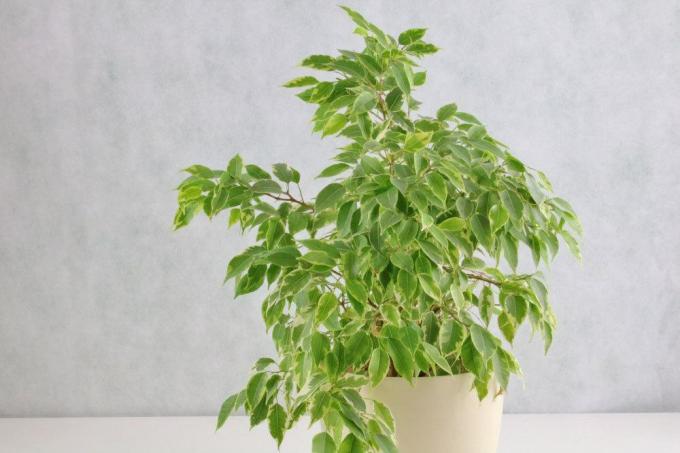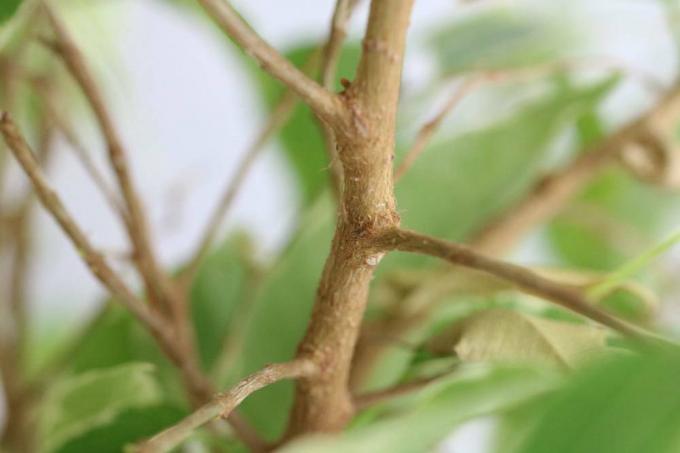
table of contents
- Cut Ficus Benjamini
- time
- Weeping fig slightly poisonous
- Preparations
- Cutting Ficus Benjamini: Instructions
- Form and maintenance cut
- Taper cut
- Clearance cut
The Ficus Benjamini does not have to be pruned annually, but it is still advisable to take care of it. Because through regular cutting, the tree sprouts particularly vigorously and can be kept in perfect shape. Below are helpful tips on cutting the Weeping fig.
Cut Ficus Benjamini
If you want to give your weeping fig new shape and strength, you should cut the green plant. The following sections explain how to do this and what to watch out for.
time
The Ficus Benjamini is generally cut when necessary, whereby scissors can be used at any time of the year. However, if you want the gentle cut possible, you should use the weeping fig in the transition from late winter to spring cut. Because at this time, the stress load is lowest due to the sap calm. However, if you want to use scissors sooner or later, you should consider the following:
- Summer: just remove a few shoots for framing
- Autumn: topiary possible
Note: If the Ficus Benjamini sheds its leaves, this is no reason for pruning! Because often the Leaf shedding to a wrong location and / or care errors. Instead of cutting back the tree directly, the cause should therefore first be identified and remedied.
Weeping fig slightly poisonous
The weeping fig is extremely easy to cut, but certain precautions should always be taken before cutting. Milky sap flows through the tree, a sticky secretion that experts call slightly poisonous is classified. Direct contact and consumption pose health risks, especially for children and pets:
- Rash
- Eczema
- allergic reaction
- diarrhea
- nausea
- Circulatory problems
Note: Small pets can suffer respiratory paralysis and die from it even if they eat small amounts of leaves! It is therefore advisable to keep pets away from weeping figs at all times and to always dispose of clippings directly.
Preparations
The sticky milky sap is not only a health hazard, it is difficult to remove from parquet, laminate and carpeted floors. In addition, the secretion can also stick the leaves together. It is therefore advisable to stop the leakage of juice as quickly as possible. The best way to do this is to press handkerchiefs or pieces of absorbent fleece onto the wound. In addition, the following precautions should be taken:
- always wear gloves and long-sleeved clothing
- Cover the floor, e.g. B. with old newspapers
- Prune weeping fig outdoors in spring / summer
- Place sapling on earth or grass
- always use sharp cutting tools
Note: The cut works best with bypass pruning shears, because these have two sharp blades and leave smooth cuts.
Cutting Ficus Benjamini: Instructions
Form and maintenance cut
With the shape and maintenance pruning, it is possible to regulate the height and width of growth so that the tree shoots bushy and compact. However, before the scissors are used, the shoots should be subjected to a vitality test. Stand the tree at eye level and scrape off some of the bark on the shoots so that you can control the exposed tissue. If this is fresh and green, the shoot is vital. However, if the tissue is brownish-dry, the shoot has died and can be cut off completely. The shape and maintenance cut is then as follows:
- cut off all dead shoots at the base
- Trim too long branches protruding from the crown
- about 2-4 mm away from the leaf base or eye
- Remove shoots that are too close together
- remove weak shoots

Note: The shorter the distance between the interface and the blade or If the knot fails, the more vital the shoot!
Taper cut
Radical pruning may be necessary for a variety of reasons: Most common is a Tapering cut required if the weeping fig takes up too much space and is trimmed accordingly must become. But neglect of care and the resulting baldness can also require radical pruning. To rejuvenate old, oversized weeping figs, it is best to use scissors from late winter in March and proceed as follows:
- cut any leafless, dead branches
- Remove diseased and dried up shoots
- cut them off completely and without stubs
- Cut close-standing and cross-growing shoots
- Cut back the remaining branches vigorously
- about hand width or up to 30 cm
- always cut above a healthy pair of leaves
It is best to repot the Ficus Benjamini in a fresh substrate at the same time, because this maintenance measure mobilizes the tree's floral strength. Repotting also enables the roots to be checked, whereby all stunted, putrid brown and dried-up roots are cut off.
Clearance cut
Even if the Ficus Benjamini can freely develop and grow as it pleases, it should be thinned out every two to three years. This maintenance measure is particularly recommended from the age of five, as dead wood is often mixed with the dense branches. This would mean that the weeping fig would burn off from the inside out. Because the buds are shaded by the dense branches, so they cannot sprout again. In order to clear the tree, it should first be set up so that it is easily visible and accessible. The weeping fig can then be thinned out as follows:
- Remove dead branches
- Cut off shoots up to 3 cm in diameter
- Saw off thicker shoots with a folding saw
- Pay attention to astring when cutting
- that is bulging compression from the branch to the trunk
- Cut dead wood a short distance from the astring

Note: If there is no astring, it should always be cut just before the trunk bark.

